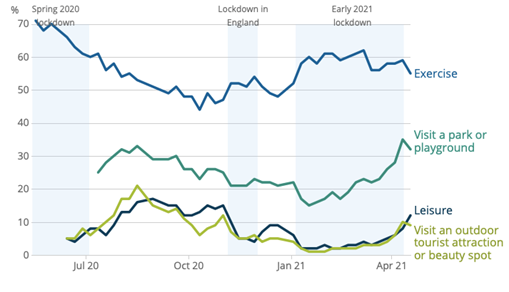Have people’s attitudes towards the environment really changed since the start of the COVID-19 pandemic? If so, why might they have changed? Are there any lessons we’ve learnt from the pandemic that could help us encourage more people to be more environmentally aware and to think ‘greener’? How can we encourage greater environmental awareness?

Lydia Mills is a third year student, studying Geography at Portsmouth University, who recently joined Grundon on a work experience placement. With a passion for sustainability and the environment, Lydia has become our guest blogger, considering the results of a recent study looking at whether or not the pandemic has changed the attitudes of people living in the UK towards the environment.
Unprecedented times
If I speak for the majority, it is fair to say that the last year and a half has certainly been a strange one.
The outbreak of the COVID-19 virus which has swept across the globe, caused much uncertainty and chaos. The world was brought to a temporary stand-still with enforced lockdowns, meaning most of us were made to work and study from home.
As a result of such unprecedent changes, many people have come to realise or had it confirmed to them, that there are major environmental issues taking place on a global scale. Issues regarding migration and controlling the spread of diseases, as well as hygiene and pollution control, all need to be mitigated, in order to help protect people and the environment from other potential pandemics and further climate devastation.
More environmentally conscious, but not as green?
The pandemic has certainly taught us a lot about the importance of living in a healthy environment and protecting ourselves from diseases.
A recent study conducted by Aviva (2021), on how the ‘Pandemic has made UK people more ‘environmentally conscious’ – but ‘green’ behaviours have dipped’, has shown that 52% of adults in the UK believe they are now more environmentally conscious since COVID struck.
To an extent, this is largely true as the first lockdown saw a great rise in people connecting with and discovering a greater love for the environment, by taking daily walks outdoors, at the time when one essential trip out of the house was allowed.
According to The Office for National Statistics (ONS), of the 28% of people who were working from home during the pandemic, 76% were more likely to leave the house once a day to visit a park or a green space for the purposes shown in the graph below.

Compared to the 56% of people who were classed as essential workers and were allowed to go to work, they were shown to have been 46% less likely to visit a park or local green area once a day. This shows that the pandemic has had more of a positive effect in encouraging those working from home to get out and enjoy their local environment, than those who continued to work outside of their home.
Engaging with nature
According to the ONS, 46% of people said in July 2020, that they had developed a greater interest in nature now that they were spending more time outside. This indicates that since the pandemic began, the majority of people caring about and appreciating their local environment is higher than ever before.
Secondly, the pandemic saw an increase in people taking more regular cardiovascular exercise, as the NHS saw an inflation of one million downloads of their running app ‘Couch to 5K’ since the first lockdown. Exercise is essential for maintaining a healthy mind and body. The pandemic has not only encouraged people to connect with nature around them, but it has also persuaded people to get fit and to look after their physical and psychological wellbeing, further fuelling people’s appreciation for the environment.
Thirdly, with more people taking regular exercise, the lockdown saw a surge of ‘pandemic puppies’ with an escalation of puppy ownership in the UK of 166%, according to Google.
Did you know – households in the UK have bought 3.2 million pets since the start of the pandemic!
This dramatic increase meant that even more people have had reason to connect with nature by leaving their homes to exercise their dogs during the lockdown. As shown by the latest pet population survey, 74% claimed that walking their dog out in their local park or woods since the pandemic had greatly helped to improve their mental health, further boosting public consciousness towards the environment.
Data from RAC Black Box Insurance, has revealed that the lockdown saw a reduction of car usage from 96% pre-COVID down to 22% post-COVID. This has had a great positive effect in reducing carbon emissions by 13% in the UK, creating areas of improved air quality and healthier outdoor environments for people to enjoy.
The underlying common theme that resonates through all of the aforementioned statistics, is that people who are conscious of their local environment are more likely to appreciate it.
In summary, the increasing number of people visiting green places to enjoy the natural environment, to walk their dogs and to take regular outdoor exercise has shown that since the pandemic, people have become more environmentally conscious and that people have realised the importance of connecting with nature for both their physical and mental wellbeing.
Are we really ‘walking the walk’?
On the other hand, whilst Aviva’s 2021 study shows although the majority claimed they believe they were more environmentally friendly since the pandemic, in reality this may not be the case. Only 4% of the population said they were less environmentally friendly, however, the percentage of UK adults not taking environmentally friendly actions since the pandemic, is considerably higher than this percentage suggests.
Aviva’s survey results show the percentage of people avoiding the use of single-use plastics was at 61% in 2019, but that figured dropped to less than 36% in 2021. However, it should be noted that this figure may have been distorted by the effects of the pandemic, where the usage of single-use plastics undoubtedly increased due to an increased focus on maintaining personal hygiene, such as through the use of disposable Personal Protective Equipment.
Similarly, the buying of upcycled/second hand items was recorded at 40% (2019) but is now less at 20% (2021). Thirdly, the percentage of people recycling through local waste collections in 2019 was 73%, but that had fallen to 51% by 2021.
These statistics indicate that some people are actually making less of an effort to protect the environment since the pandemic and are opting for less ‘green’ alternatives.
From this it can be argued, that some people’s actions towards protecting the environment have not changed that much at all, despite their words saying otherwise.
Valuable lessons learnt
Despite the figures listed in Aviva’s study, it is my belief that since the start of the pandemic people have become more environmentally considerate.
For example, as we have started to transition back to normality, with services starting up again and people returning back to work, there has been increased traffic on the roads. However, car use is still lower across the UK than that of pre-COVID conditions. As shown by data from RAC Black Box Insurance, car usage has continued to decrease down to just 10% from the immediate post-COVID level at 22%.
This suggests that people are taking more conscious steps to protect the environment by choosing to remain at home to work or are cutting back on their mileage.
Although we still have a long way to go in terms of getting more people to choose ‘greener’ options in their everyday lives, the pandemic has certainly taught us that we can operate businesses from home and that by cutting back on journeys to work we can make a difference to the environment. It has also made more people aware that their actions have implications and that they can help to make a difference to the global climate – which could prove to be a very valuable lesson learnt.
